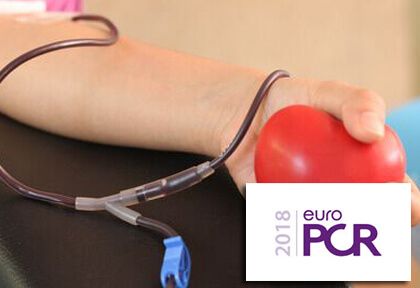The left distal radial artery has been recently proposed as an alternative in selected patients with high success rate and low complications rate. This study evaluated the feasibility and safety of this puncture both for coronary angiography and angioplasty. It included 200 consecutive patients with palpable left distal radial artery punctured by three expert operators.…
EuroPCR 2018 | Compare-Acute: FFR or Primary Angioplasty at a 2-Year Follow-Up After Complete Revascularization
Recent studies in patients undergoing acute myocardial infarction showed that a complete revascularization strategy in an acute or subacute setting, whether it be guided through angiography (PRAMI, CvLPRIT) or fractional flow reserve (FFR) (PRIMULTI, COMPARE-ACUTE), improves the combined endpoint of major adverse cardiac events (MACE) when compared with treatment of the culprit artery only. Based…
EuroPCR 2018 | BIO-RESORT: Polymer vs. Bioresorbable Polymer; Have We Reached a Plateau with DES?
This study randomized 3514 patients to a thin-strut biodegradable polymer everolimus-eluting stent (SYNERGY) vs. a sirolimus-eluting stent (ORSIRO) vs. a durable polymer zotarolimus-eluting stent (RESOLUTE INTEGRITY). The combined endpoint, the rate of target vessel failure, was similar for all three devices (8.3% for the zotarolimos-eluting stent, 6.8% for the everolimus-eluting stent, and 6.6% for the sirolimus-eluting…
EuroPCR 2018 | FFR Reduces Death and Infarction Rates Compared with Medical Treatment
Pooled data from the most important recently published studies (FAME 2, Compare-Acute, and DANAMI3-PRIMULTI) conclude that there is a significant difference in favor of fractional flow reserve (FFR) as regards hard endpoints. Coronary revascularization guided by FFR reduces the risk of death and infarction when compared with optimal medical treatment in patients with stable and…
EuroPCR 2018 | FAME 2: FFR Shows 5-Year Benefit for Hard Endpoints
After a 5-year follow-up, and for the first time, functional assessment with fractional flow reserve (FFR) showed clear benefit for a hard endpoint: acute myocardial infarction. Use of FFR in patients with stable coronary artery disease so as to identify hemodynamically significant lesions in order to restrict angioplasty treatment to them has long-term benefits compared…
EuroPCR 2018 | ORBITA: The Link Between Ischemia and Symptoms Is Still Not Entirely Understood
Invasive physiology tests used in the ORBITA trial could not predict which patients would benefit from angioplasty more than placebo (sham procedure) in terms of the trial’s primary endpoint, improvement in exercise time. These data were presented at EuroPCR 2018 and published simultaneously in Circulation. Results encourage debate over the importance of ischemia reduction with angioplasty…
EuroPCR 2018 | SYNTAX III REVOLUTION: Excellent Correlation Between Angiography and Computerized Tomography in Patients with Left Main and Multivessel Disease
In patients with left main or three-vessel coronary disease, heart team decisions on revascularization strategy (angioplasty or surgery) may be made based solely on noninvasive computerized tomography (CT) angiography, since there is great correlation between its results and those determined by conventional angiography. For the SYNTAX III REVOLUTION study, Dr. Serruys and his colleagues randomized…
EuroPCR 2018 | SCAAR Registry at 10 years: FFR improves decision making in the long term
The SCAAR registry aimed at showing the differences in mortality at very long term when using functional assessment of coronary lesions (with FFR or iFR) in patients with chronic stable angina. The study compared 3460 patients assessed with FFR/iFR against 21221 patients undergoing PCI based on angiography, between January 2005 and March 2015. As…
Maintaining Physical Activity After an Acute Myocardial Infarction Reduces Mortality
Performing a successful primary angioplasty and prescribing preventive medication without advising on the importance of keeping up with or taking up physical activity is a waste of one of our many opportunities to improve the quality of life of our patients and reduce mortality among them. If clinical cardiologists do not take over the patient,…
Restenosis Does Not Seem as Benign as We Thought
Elective, uncomplicated repeat revascularization after stent restenosis is associated with higher mortality rates according to a new meta-analysis that will be published soon in J Am Coll Cardiol Intrv. Historically, interventional cardiologists have seen target lesion revascularization (TLR) as a procedure that “unjustly” increased combined events in clinical studies and our own databases, thus representing…
Hybrid Revascularization or Conventional Surgery: History Is Still Being Written
Hybrid revascularization seems to achieve results similar to those of conventional myocardial revascularization surgery at 5 years, although studies published so far do not seem to be enough for a definitive answer. This new work, soon to be published in J Am Coll Cardiol Intv, has had promising results in selected patients with multivessel disease; however,…










